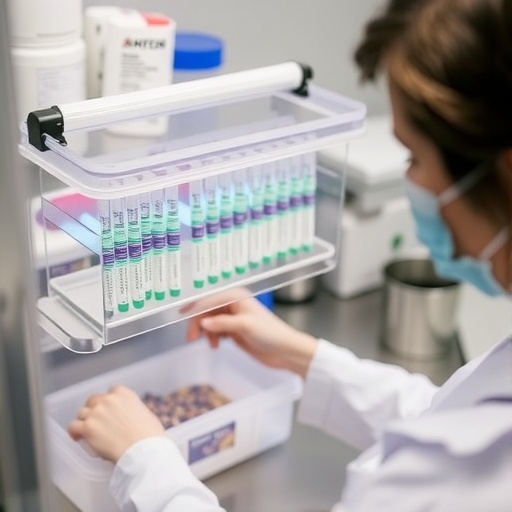The sexual habits of Trichophyton rubrum, the fungus that causes athlete's foot and other kinds of skin and nail infections, were the focus of a study published by Brazilian scientists and international collaborators in the journal Genetics.
The researchers' findings suggest that asexual reproduction is the rule for this species. Mating between individuals is not common and requires highly specific conditions if it does occur. As a result, the genetic variability in the population is low even when comparing isolates from different parts of the world.
"We found the population to be clonal. There's practically no mating between individuals, and few variations in the genome are created," said Gabriela Felix Persinoti, lead author of the study, which was performed during her postdoctorate with support from the São Paulo Research Foundation – FAPESP.
According to the principal investigator of the project, Nilce Martinez-Rossi, a professor at the University of São Paulo's Ribeirão Preto Medical School (FMRP-USP) in Brazil, understanding how the fungus reproduces is basic science, but progress in applied research is impossible without it.
"Genetic variability is a factor to be considered in drug development, for example, as it may point to the risk that the pathogen will adapt and develop resistance to treatment," she said.
Scientists have discovered that the greater the genetic variability among individuals of a given species is, the likelier these individuals are to adapt to adverse conditions and survive.
Persinoti's work is part of one of two research lines coordinated by Martinez-Rossi at FMRP-USP. This line's goal is to investigate how dermatophytes – fungi that cause skin, hair and nail infections – interact with their hosts. The other line aims to understand the mechanisms of drug resistance in this same group of microorganisms.
T. rubrum is a dermatophyte species that infects only humans, Martinez-Rossi explained. Infections are typically chronic and superficial since the fungus feeds on the keratin in skin and nails. These infections cause discomfort, itching, and structural damage to nails, impairing the infected individual's quality of life. In rare cases, generally associated with low immunity, the infection may spread through the patient and become life-threatening.
"We want to unpack the molecular mechanisms of pathogenicity in these dermatophytes – in other words, to understand how they cause infection. Revealing the 'weapons' these fungi use during the infectious process will contribute to the development of drugs to combat them," Martinez-Rossi said.
Persinoti conducted her study in Christina Cuomo's laboratory at the Broad Institute of MIT and Harvard in the United States during a research internship abroad funded by FAPESP.
Genomic analysis
As the authors of the article explain, the species Trichophyton rubrum is actually a complex that can be subdivided into several different morphotypes. These morphotypes are highly similar fungi with small variations in color or structure or in the compounds they produce.
In the first stage of the research, Persinoti and collaborators analyzed the genetic variability in 100 morphotypes isolated in several parts of the world. To do this, they used multilocus sequence typing (MLST), a method that sequences key fragments (or loci) of DNA rather than the whole genome.
"To complement this analysis, 12 isolates were submitted to whole-genome sequencing," said the FAPESP-funded researcher.
This more deeply analyzed sample comprised ten morphotypes of T. rubrum and two isolates of T. interdigitale, which also infects humans; none of the genomes of these isolates have been described hitherto.
After sequencing, the group focused on analyzing a genomic region known as the mating type (MAT). Individuals cannot mate unless they have complementary MATs – one must have MAT 1 and the other MAT 2, for example.
Mating has been observed in some dermatophytes in studies by other groups, but so far, mating has never been observed in T. rubrum.
"When we analyzed this genomic region, we found MAT 1 in almost all morphotypes of T. rubrum and MAT 2 in only one morphotype," Persinoti said.
The scientists conducted laboratory experiments designed to induce sexual reproduction between the MAT 2 isolate and MAT 1 individuals, but the fungi failed to mate.
"This led us to the conclusion that sexual reproduction in this species probably doesn't happen or requires a very specific condition in order to take place," Persinoti said.
The conclusion was reinforced by other experiments performed during the FAPESP-supported research, which showed that similarity in the genomes of the individuals analyzed exceeded 99%.
According to Persinoti, however, the genes required for sexual reproduction found in other dermatophytes are still present in T. rubrum. This suggests that the transition to asexual reproduction is a recent event in the species and could be associated with its specialization in infecting humans.
"We performed a series of phylogenetic comparisons between the different morphotypes, and the results enabled us to delineate the species more correctly. One of the morphotypes, known as soudanense, proved to be divergent from the rest and could come to be considered a separate species," Persinoti said.
###
About São Paulo Research Foundation (FAPESP)
The São Paulo Research Foundation (FAPESP) is a public institution with the mission of supporting scientific research in all fields of knowledge by awarding scholarships, fellowships and grants to investigators linked with higher education and research institutions in the State of São Paulo, Brazil. FAPESP is aware that the very best research can only be done by working with the best researchers internationally. Therefore, it has established partnerships with funding agencies, higher education, private companies, and research organizations in other countries known for the quality of their research and has been encouraging scientists funded by its grants to further develop their international collaboration. For more information: http://www.fapesp.br/en.
Media Contact
Joao Carlos da Silva
[email protected]
55-113-838-4381
@AgencyFAPESP
http://www.fapesp.br
http://dx.doi.org/10.1534/genetics.117.300573




